|
Varietal Selections |
|
|
 |
 |
|
|
ORANGE |
 |
The sweet orange
varieties being grown by Filipino farmers are
introduced cultivars. Prominent among these are
Navel, Hamlin, Valencia, Pineapple orange
|
|
| |
The Japanese orange,
with small leaves, is a dwarf variety and is
ideal for bonsai gardens. It can bear fruits
continuously throughout the year. Its fruit is
medium size, sweet in taste and contains only a
few seeds, sometimes none.
It is very prolific and can be induced to bear fruit
quite easily by simply applying organic and
complete fertilizer. It is resistant to pests
and diseases. [Clieck
Here for More Info]
|
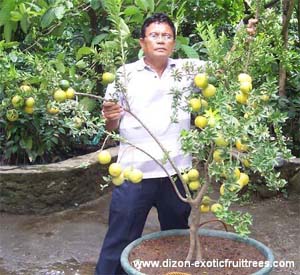 |
|
|
|
| Navel orange trees
bears big fruits known for their outstanding
sweetness and flavor. The top orange variety and the
most expensive in the United States, it is the only
sweet orange that is easily to peel. It is seedless
(zero to six seeds a fruit), and matures early.
|
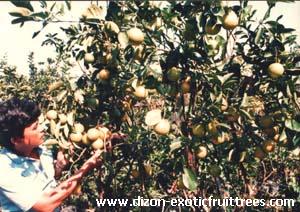 |
|
| Hamlin orange
is well known to Filipinos although we ay not have had an
inkling about this. The imported "Sunkist" brand oranges now
sold on the sidewalks and markets in our big towns are
Hamlin. The tree bears small to medium-sized fruits that are
also seedless and early maturing. Although its quality is
inferior compared to other sweet oranges, Hamlin's
productivity, seedlessness, and early fruiting makes it
popular orange in the US, especially in Florida.
Valencia orange
may be the world's leading
commercial sweet orange variety. The tree's fruit is medium
to large-sized and seedless. It's eating quality is the
standard of excellence against which other sweet oranges are
ranged. This variety, however, may not be profitable to grow
in the Philippines. This is because the flowering to
ripening period of this variety takes 14 months. Many
orchardists and home gardeners in Luzon today, especially
those who bought seedlings from nurseries in Laguna and
Batangas, they think they have planted Valencia orange
trees. But the trees may be actually a grapefruit, thus bear
fruits that are not sweet. We do not know whether this is an
honest mistake of the propagators (leaves. flowers and tree
shape of both varieties are identical but grapefruit, being
a proximate pummelo cousin, has much larger fruit), or if
they deliberately fooled people. Because of Valencia
orange's popularity, they may have wanted to make fast money
by passing off budded grapefruit seedlings as Valencia
orange.
Pineapple orange
is the leading mid-season sweetest orange in the US where it
was originated. The somewhat flattened fruit is medium to
large-size and contains 15 to 25 seeds per fruit. In eating
quality, it is better than Hamlin |
| |
|
MANDARIN |
| Mandarin
varieties are sweet citrus which bear fruits that
are easier to peel compared to oranges.
Imported Mandarin
comprises of the imported Ponkan from Taiwan,
Satsuma orange from Japan and ponkanitas or small
ponkan fruit.
The locally produced (dalanghita)
are also imported Mandarin from Florida, USA. It
lacks potash during fruiting time that is why the
fruit are sour.
|
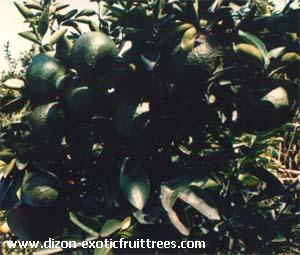 |
|
| All these oranges and Mandarin
have been tested to bear fruits in lowland areas but was
found to be best-suited in upland areas like Cordillera. The
cool climate influences the orange color of the rind but the
warm temperature or longer sunlight makes the fruits sweet. |
| |
|
GRAPEFRUIT |
| In the US, grapefruit is more
expensive than oranges because of its health effect
particularly in maintaining slim figures for women.
Because it is not sweet just
like our native pummelo, most Filipino consumers reject
grapefruits. Nevertheless, Filipino women still buy
grapefruit capsules to maintain their slim bodies. To suit
the Filipino taste grapefruit's quality can be improved by
applying potassium fertilizer to the tree during fruiting
time.
The good news is, a new variety
of grapefruit from the US is currently being propagated for
future distribution. This variety is seedless, has red flesh
and it is neither sour nor bitter.
Grapefruit is a small tree that
bears fruits continuously in the Philippines using the
double rootstock technology. |
| |
|
LIME, LEMON |
| These three sour varieties of
citrus are primarily used for juice and flavoring purposes.
The
native lime
is susceptible to gummosis that
makes the lifespan short. Application of too much Nitrogen
(urea) or no fertilizer (balanced nutrition) enhances
gummosis that kills lime. |
| The
imported Thai Lime from Thailand is more
resistant to gummosis that our native lime which
has a distinct flavor. |
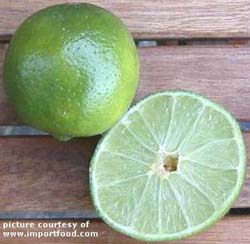 |
|
| |
| Bearse lime
is a big as the orange fruit; it is seedless and juicy thus,
an excellent juice material. It continuously fruits in our
demo farm. Lemon
has thick rind and
juice. It is often used as a mix for flavoring of alcoholic
beverages as well as juice. |
| |
|
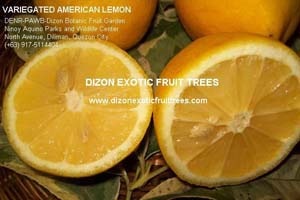 |
VARIEGATED AMERICAN LEMON.
Besides the green leaf
lemon that came from the US, there is now
variegated leaf lemon
that
can be used both as ornamental and economic
decorative tree in your garden.
(click picture to see
gallery) |
|
| |
|
CALAMANSI |
| Calamansi
or
calamondin is a
native citrus that mostly used in everyday kitchen for juice
and flood flavor.
Although calamansi
is a seasonal fruit (particularly those which come from
Batangas and Mindoro where they bear fruits only during
rainy season), it could be induced to bear fruit when
provided with irrigation. During off-season fruiting,
calamansi can be sold even at P60 per kilo.
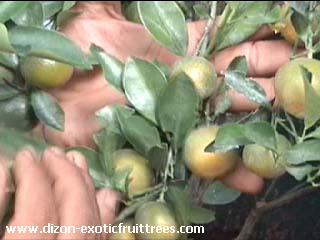 |
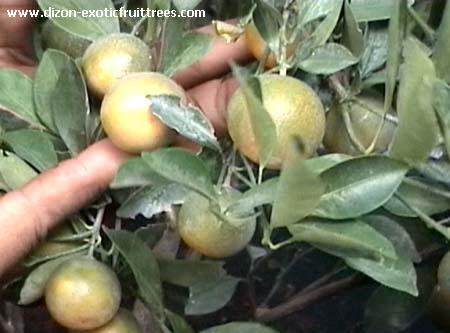 |
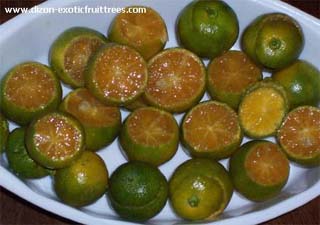 |
The
Luz calamansi
is a fast grower,
prolific and is much juicier than the native
variety. Moreover, it has only two seeds
compared to native calamansi which has 12 seeds.
The Luz calamansi variety is ideal for container
growing and bears fruits continuously throughout
the year. |
For backyard planting, the
Tomboy calamansi
which has big fruits could
be planted even in cans or plastic containers. |
| |
|
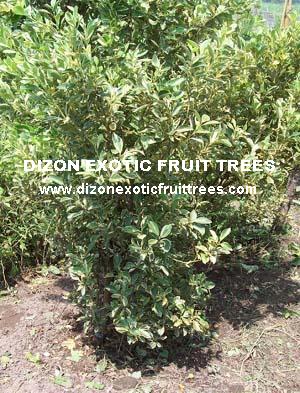 |
There is also a
variegated calamansi
with juice similar to native calamansi that
could serve as an ornamental plant in your
garden |
|
 |
|
| |
|
|

